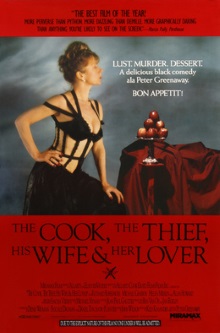
This is a better known film by Peter Greenaway and I’d bet most people watch this one earlier than The Baby of Mâcon. It is very recognizable made in the same style down to similar fonts used in the titling but is far more comprehensible. It doesn’t try to hide the fact that it’s all filmed on a stage but neither does it pretend to be a play.
Gangster Albert Spica has forcibly taken over his favorite restaurant run by its chef Richard Boarst and goes to eat there every evening. He is accompanied by his reluctant wife Georgina and his underlings, and he freely abuses and denigrates all and sundry, including the other guests at the restaurant. Georgina notices another regular diner, Michael, who eats alone and reads books at the table while doing so. They seemingly fall in love without speaking a single word to one another and soon enough are meeting in the restroom for a tryst. Richard is aware of their affair and together with the rest of the restaurant’s staff helps them cover their tracks. This goes on for several days as the pair of lovers meet only ever in the restaurant but it is only a matter of time before the violent and boorish Albert finds out.
As with The Baby of Mâcon, everything has a very stage-like look and the sets, colors, costumes, and of course the food all look exquisite and sumptuous. It even uses a young boy soprano to sing a song about cleansing from iniquity, giving the piece a decidedly religious feeling. Helen Mirren as Georgina wears some pretty outlandish outfits in here and it is especially notable how the clothes change color as the characters step between different parts of the restaurant. As many others have noted, she and Alan Howard as Michael, spend plenty of time being naked as well, up to full front nudity. But the sex and nakedness never feels exploitative or even titillating due to how the shots are framed. Instead they look beautiful and artistic. Even disregarding the plot and the themes, this is a fantastic work of art, offering a unique audio-visual experience that marks Greenaway as a very distinctive auteur.
Again in keeping with stage plays, the plot matters less than the themes and esthetics. Greenaway isn’t being subtle here as Albert lays it on thick about how the sexual organs are so close to the organs for eating and excreting. When Georgina and Michael have sex, a cornucopia of food is always visible in the scene. Albert has no hang ups about torturing a man by splashing him in feces and then heading off for dinner right afterwards. Albert talks big about knowing a lot about food and is shown to have a voracious appetite but Georgina reveals that his interest in sex is as shallow as his taste in food. Sex, food, violence and death are all intimately related as the film lays out and while it’s not new, the quality of the presentation makes it a visceral and powerful experience.
Of the two, The Baby of Mâcon is still the more original and hence impressive work but this is great as well. I continue to enjoy how Greenaway’s style blurs the boundaries between a film and an art installation and I’ll probably look into more of his work in the future.